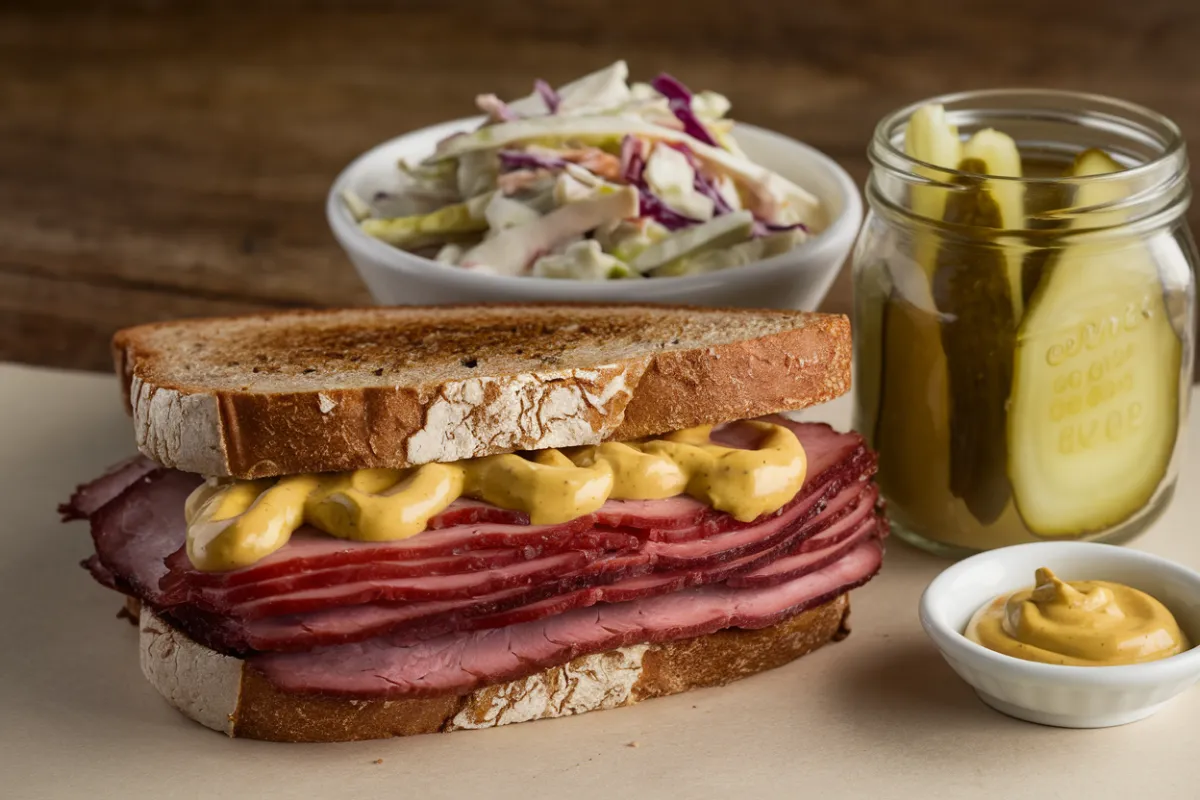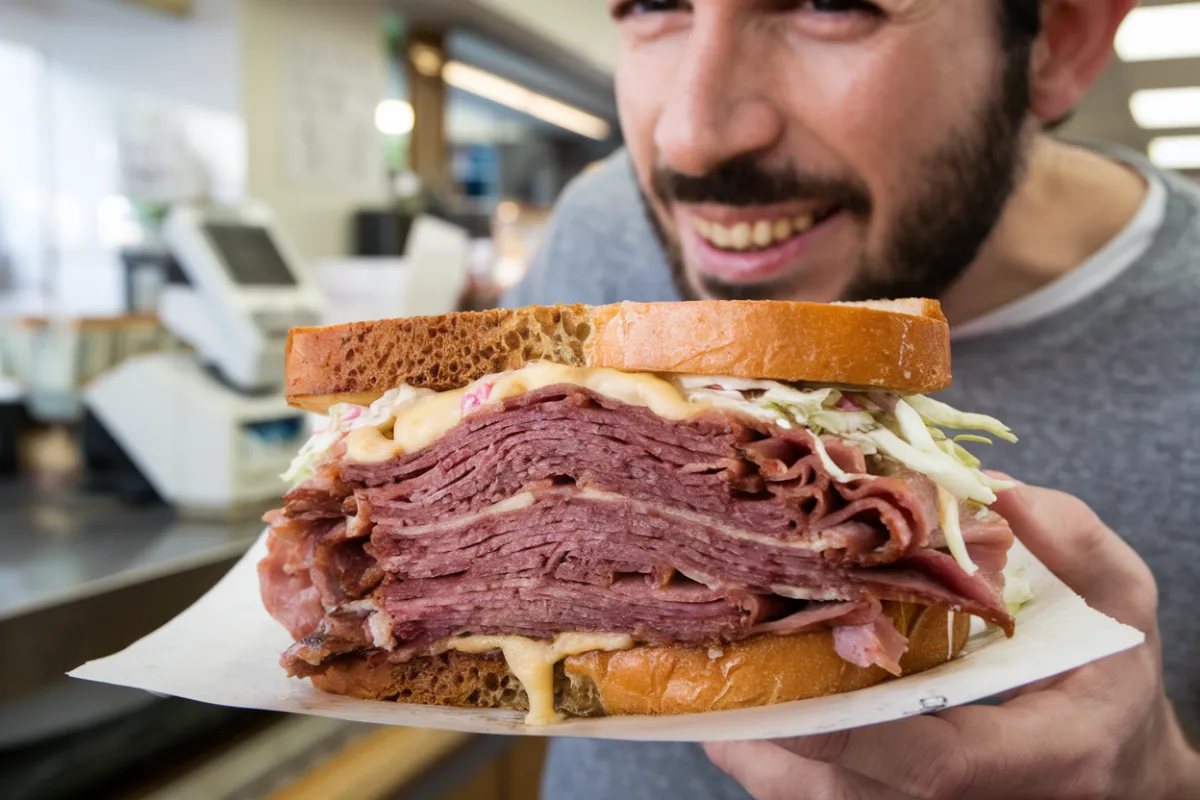The origins of pastrami trace back to Romania, where it was traditionally made from mutton or pork. When Romanian Jews emigrated to the United States in the late 19th century, they brought their food traditions with them. Since kosher laws prohibit pork, Jewish immigrants adapted the recipe to use beef instead. This was not only more readily available in America but also fit within the rules of kashrut.
Jewish delis in New York City soon popularized the pastrami sandwich, serving it on rye bread with mustard. These delis became cultural hubs, offering familiar foods in an unfamiliar land. The pastrami sandwich quickly became a symbol of Jewish-American cuisine, celebrated for its hearty flavor and satisfying texture. Delis like Katz’s have preserved this tradition for over a century, using age-old methods of curing, smoking, and steaming to produce their signature pastrami.
In essence, pastrami represents both a culinary adaptation to American life and a deep connection to Jewish cultural roots. Its popularity has transcended Jewish delis, but it remains a beloved dish that reflects the immigrant experience and Jewish food traditions.
The Origins of Pastrami
The story of pastrami begins in Romania, where it was originally made from mutton or pork. In Romania, pastramă was a traditional way of preserving meat through curing, spicing, and sometimes smoking. This preservation method allowed the meat to last longer, making it ideal for communities without access to refrigeration. The word pastramă comes from the Romanian verb a păstra, meaning “to preserve” or “to keep.”
When Romanian Jewish immigrants arrived in the United States in the late 19th century, they brought their food traditions with them, including pastramă. However, since Jewish dietary laws, or kashrut, prohibit the consumption of pork, these immigrants adapted the recipe to use beef instead. This change was crucial because beef was both more readily available in America and adhered to Jewish kosher laws. This transformation allowed pastrami to align with Jewish traditions and remain a beloved dish within the community.
If you’re interested in learning more about the history of pastrami and its connection to Jewish delis, you can explore the full story of how pastrami got to Jewish delis.
Jewish Migration and the Evolution of Pastrami
The evolution of pastrami into a Jewish-American staple is closely tied to the history of Jewish immigration to the United States, particularly to New York City. Romanian Jewish immigrants settled in the Lower East Side, an area that became home to many Jewish delis, where pastrami sandwiches quickly gained popularity. The delis served beef pastrami on rye bread, usually with mustard, creating the iconic sandwich that we know today.
Jewish delis not only offered a taste of home but also became gathering places for Jewish immigrants, preserving cultural and culinary traditions. Over time, the pastrami sandwich became a symbol of Jewish-American cuisine. Despite the decline of traditional Jewish delis over the years, places like Katz’s Delicatessen continue to serve pastrami sandwiches made the old-fashioned way. Katz’s has been serving pastrami since 1888 and remains a symbol of the rich culinary heritage that Jewish immigrants brought to America. Learn more about famous Jewish delis in New York and their cultural significance.

Why Pastrami Became Popular in Jewish Cuisine
Several factors contributed to the rise of pastrami in Jewish cuisine:
- Kosher Dietary Laws: Jewish dietary laws, or kashrut, forbid eating pork, which led to the substitution of pork with beef when making pastrami. Beef, particularly brisket, became a suitable alternative because it could be prepared in accordance with kosher rules.
- Preservation Methods: Curing and smoking, which are integral to making pastrami, align with traditional Jewish methods of meat preservation. These techniques allowed meat to be stored and consumed over longer periods, which was essential in the days before refrigeration.
- Delis as Cultural Hubs: Jewish delis provided more than just food; they were also gathering spots for Jewish communities. The pastrami sandwich, served on rye bread with mustard, became a symbol of Jewish-American identity, offering both nourishment and a connection to cultural roots.
The Role of Jewish Delis in Pastrami’s Popularity
Jewish delis, particularly in New York, played a critical role in popularizing pastrami in America. These delis became famous for their pastrami sandwiches, which quickly became a favorite among both Jews and non-Jews alike. The unique preparation of pastrami—cured, spiced, smoked, and steamed—sets it apart from other types of deli meats.
The decline of traditional Jewish delis has been significant. By the 1930s, New York had over 1,500 Jewish delis; today, only a small fraction remain. However, the legacy of these delis, especially when it comes to pastrami, lives on. Places like Katz’s Delicatessen still make pastrami using traditional methods: a three-week brining process, followed by three days of smoking and three hours of boiling. This meticulous preparation ensures that the pastrami is tender, flavorful, and true to its roots.
Kosher Pastrami: Dietary Restrictions and Preparation
The concept of kosher pastrami is deeply tied to Jewish dietary laws. To qualify as kosher, pastrami must be made from beef, and the entire process—from slaughtering the animal to preparing the meat—must follow strict kosher guidelines. This includes using kosher salt for curing and ensuring that no prohibited ingredients are included.
- Kosher Salt: One of the key elements in curing kosher pastrami is kosher salt, which helps to draw out moisture from the meat while infusing it with flavor.
- Kosher vs. Non-Kosher Pastrami: While kosher pastrami adheres to traditional Jewish dietary laws, not all pastrami served in restaurants is kosher. Many delis serve non-kosher versions that use different curing processes or ingredients.
If you want to understand more about kosher food and its preparation, check out this detailed guide on kosher rules and food preparation.
Modern Variations and Adaptations of Pastrami
Though the traditional pastrami sandwich remains a favorite, modern variations have emerged. In Jewish cuisine, pastrami has been adapted into several dishes, expanding its use beyond the classic sandwich. Some popular adaptations include:
- Pastrami Knishes: A twist on the classic knish, filled with pastrami.
- Pastrami on Bagels: Instead of the usual rye bread, bagels serve as the base for this popular variation.
- Pastrami Reuben: A variation of the Reuben sandwich, where pastrami replaces corned beef.
Beyond Jewish cuisine, pastrami has found its way into mainstream American dishes, such as pastrami tacos and pastrami pizzas, showcasing the versatility and widespread appeal of this cured meat.
The Future of Pastrami: A Cultural Icon
Though the number of traditional Jewish delis has declined, pastrami remains a beloved dish in both Jewish and non-Jewish circles. Chefs continue to experiment with new ways to incorporate pastrami into dishes, while staying true to its roots. In many ways, the future of pastrami reflects the broader trends in Jewish cuisine, where traditional foods adapt to modern tastes without losing their cultural significance.
Frequently Asked Questions
1. What is pastrami traditionally made from?
Pastrami originated in Romania and was traditionally made from mutton or pork. When Jewish immigrants brought the dish to America, they substituted pork with beef to comply with kosher laws.
2. Why is pastrami important in Jewish delis?
Pastrami became a staple in Jewish delis due to its kosher adaptability and cultural significance. It represents the intersection of Jewish culinary traditions and American immigrant culture.
3. Is pastrami always kosher?
Not necessarily. While many Jewish delis serve kosher pastrami, non-kosher variations exist, especially in non-Jewish delis and restaurants.
4. How did pastrami come to America?
Romanian Jewish immigrants brought pastrami to America in the late 19th century. They settled in New York, where they adapted the traditional recipe to use beef instead of pork.
Pastrami has evolved from its Romanian roots into a central part of Jewish-American cuisine. Whether enjoyed in a traditional Jewish deli or as part of a modern fusion dish, it continues to offer a flavorful connection to cultural heritage
Conclusion
The cultural and historical significance of pastrami in Jewish-American cuisine stems from a complex fusion of tradition, immigration, and adaptation. Pastrami’s origins trace back to Eastern Europe, where Jewish communities preserved meats through curing and smoking, techniques that made their way to the United States with Jewish immigrants in the late 19th and early 20th centuries. As these immigrants settled in cities like New York, they adapted traditional recipes to fit the ingredients available in America, leading to the creation of pastrami as we know it today.
Delicatessens, particularly in New York, played a pivotal role in elevating pastrami to its iconic status. These establishments became social and cultural hubs for Jewish communities, where pastrami sandwiches served as a symbol of both comfort and identity. Over time, pastrami transcended its ethnic roots, becoming a beloved staple in American cuisine while still maintaining its deep ties to Jewish heritage.
Today, pastrami is not just a food but a representation of Jewish resilience, adaptation, and cultural contribution to the broader American narrative. It remains a popular dish that evokes nostalgia for Jewish-American families and continues to be a celebrated offering in delicatessens across the country. For more side dish ideas, check out Hadley Recipes.

